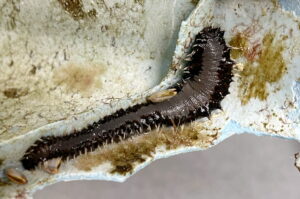
December 21, 2023
During a stormy walk on Kailua Beach this week, I found a broken bucket and brought it home for an art project. Usually, I soak my finds in a bleach solution to loosen the algae and encrusting marine animals growing there. This time, though, the underside of my plastic piece held a surprise. While rinsing off the sand, I found a bristleworm, weak from its ordeal on land but still waving its furry feet.
Getting picked up by me was the little worm’s lucky day.
Bristleworms are a class of segmented marine worms with over 10,000 species. Their scientific name, Polychaete (POLLY-keet) means many hairs, referring to the bristly projections poking out of the worms’ paddlelike feet, one on each side of each body segment.
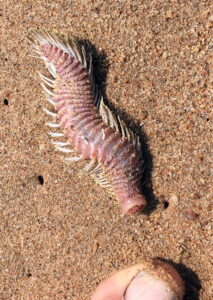
A bristleworm with long bristles, species unknown, found on a beach in Townsville, Queensland, Australia. ©Craig Thomas
Bristleworms live nearly everywhere in the ocean, either burrowing into sand and mud, crawling on and under rocks, living in self-built tubes, or swimming in the water column. Some species are stay-at-homes, living their entire lives inside the tube. Others wander around looking to eat any animal they find, dead or alive.
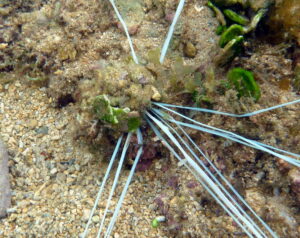
This bristleworm is called a spaghetti worm. The worm lives in a self-made tube, hanging onto the sides with its feet. Sticky white tentacles emerge from the worm’s mouth, catching passing plankton. Oahu’s North Shore. ©Susan Scott
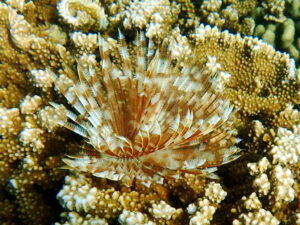
This featherduster worm is another bristleworm that lives inside its own tube home. The extended fan collects passing plankton. When disturbed, both spaghetti worms and featherdusters withdraw their feeding parts into their mouths, making the worms hard to find. ©Susan Scott
Hawaiʻi hosts about 250 bristleworm species. Within the bristleworm clan are the fireworms, or ʻaha huluhulu, meaning hairy cord. At least seven fireworm species inhabit our coastal waters.
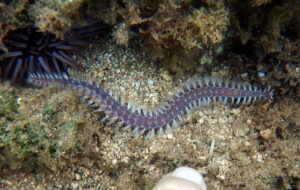
An iridescent fireworm, Eurythoe complanata, grows to about six inches long. Oahu, North Shore. ©Susan Scott
Fireworms get their name from their hollow, barbed bristles that sometimes contain toxic fluid. Like some cactus spines, fireworm bristles break off easily in human skin, causing a prickling or burning sensation.
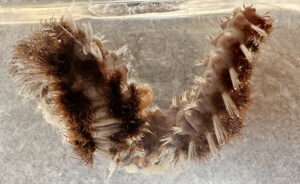
This photo clearly shows our bristleworm’s segments ending in feet tipped with stiff hairs. ©Craig Thomas
Fireworm stings can feel itchy or numb and make a rash. Nearly all clear up on their own in a few days. I don’t know for sure that my kitchen guest was a fireworm, but chances were high. One stinging species lives offshore on driftwood, eating gooseneck barnacles.
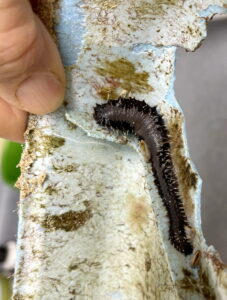
I kept my thumb a safe distance from the worm’s bristles, possible the pokey, toxic kind. The gooseneck barnacles on the lower right may have been meals for the worm. ©Craig Thomas
Taking no chances, I used a spoon to gently pry my fuzzy friend off its plastic perch, and eased it into a container of seawater. (I keep a gallon jug of seawater in my pantry for just such emergencies.)
After admiring the worm’s hairy, squiggly feet, and memorializing its life in photos and video (above), Craig bicycled our bristleworm to the Kailua boat ramp and set it free. Merry Christmas, little voyager.
Floating ocean plastic is junk to most people, but to me it’s art material. And when its a life raft for a marine animal, it’s a double treasure.
Thank you, dear readers, for continuing to share my appreciation of life on land and in the sea. Hoping for lots of snorkeling trips and beach walks in 2024.